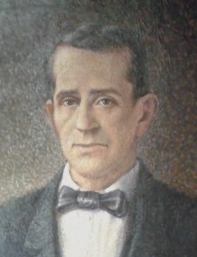José María Cañas facts for kids
Quick facts for kids
José María Cañas
|
|
|---|---|
 |
|
| Born | September 23, 1809 Suchitoto, El Salvador |
| Died | October 2, 1860 (aged 51) Puntarenas, Costa Rica |
| Allegiance | |
| Rank | General |
| Battles/wars | Filibuster War |
José María Cañas Escamilla (born September 23, 1809 – died October 2, 1860) was an important military leader from El Salvador. He was born in Suchitoto, El Salvador. Later, he became a key figure in Costa Rica's history.
Contents
Life and Career of José María Cañas
José María Cañas moved to Costa Rica in 1842. He traveled with General Francisco Morazán. In Costa Rica, he married Guadalupe Mora Porras. She was the sister of President Juan Rafael Mora Porras.
Early Roles in Government
Cañas held several important jobs in the Costa Rican government. In 1844, he became the Customs Administrator. This meant he managed taxes on goods coming into the country. By 1847, he was named State General. In 1849, President Juan Rafael Mora Porras chose him as Secretary of War. This made him responsible for the country's military. Later, in 1850, he became the Governor and Commander of Puntarenas. Puntarenas is a very important port city.
Fighting in the Filibuster War
In 1856, Cañas was promoted to General. He led the Costa Rican Army during a major conflict. This was the war against William Walker. Walker was a filibuster, meaning he was an adventurer who tried to take control of countries. Cañas was known for being kind and friendly to his soldiers. This made him very popular among his troops.
Developing Puntarenas
General Cañas played a big part in developing Puntarenas. This is Costa Rica's main port on the Pacific Ocean. He served as its commander for many years. In 1855, he brought 32 Chinese workers to Puntarenas. Many of them worked on his farms. Cañas was a good boss to these workers. Even today, many of their descendants remember him fondly. Years after Cañas passed away, his children were still welcomed in Puntarenas. The Chinese-Costa Rican community there was growing and thriving.
Important Treaties and Borders
Cañas also represented Costa Rica in signing important agreements. He signed the Cañas-Jerez Treaty and the Cañas-Martínez Treaty. These treaties helped define the border between Costa Rica and Nicaragua. The agreements were even approved by U.S. President Grover Cleveland.
Later Life and Legacy
In 1859, Cañas's brother-in-law, President Mora Porras, was removed from power. Cañas went back to El Salvador with him. The next year, they returned to Costa Rica. They hoped to help Mora Porras become president again. However, their plan failed. They were captured by troops loyal to the new president, José María Montealegre. Cañas was even threatened by soldiers who used to be under his command.
Juan Rafael Mora Porras was executed on September 30, 1860. José María Cañas was executed in the same way on October 2, 1860. This happened in Puntarenas. Cañas was the last major Costa Rican leader to be executed because of political reasons. About 20 years after his death, President Tomás Guardia abolished the death penalty. Tomás Guardia had served under Cañas in 1856.
Several years later, Cañas's wife and children returned to Costa Rica. His family did very well and was welcomed back into society. His only son who survived, Rafael Cañas Mora, became a successful businessman. He also served in the Costa Rican congress. Many of Cañas's descendants have become important people. These include Alberto Cañas Escalante, a famous writer and politician.
Cañas is seen as a national hero in Costa Rica. There is a monument of him in Parque Cañas in Puntarenas. This park was named after him in 1956. His great-grandson, Alberto Cañas Escalante, attended the dedication ceremony. The park is located near the old railroad, Ferrocarril Eléctrico al Pacífico.
See also
 In Spanish: José María Cañas para niños
In Spanish: José María Cañas para niños

